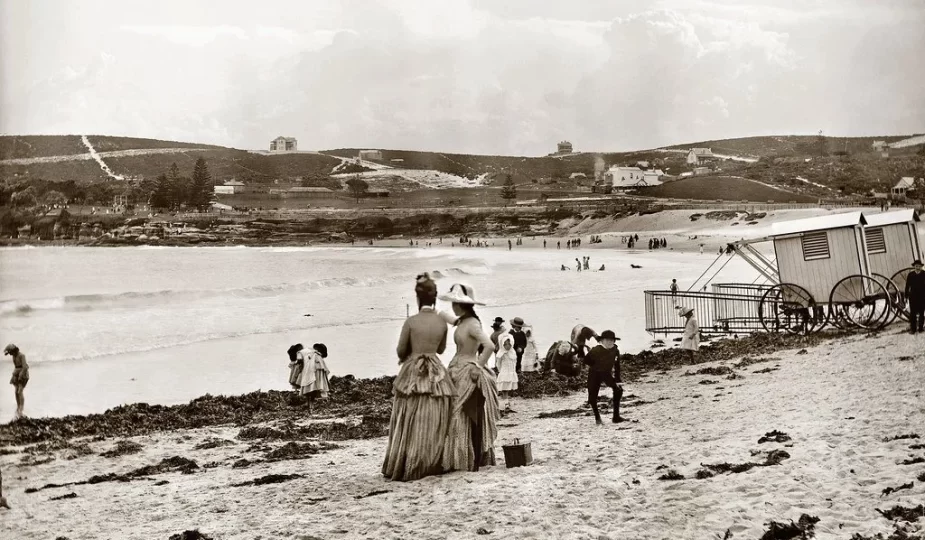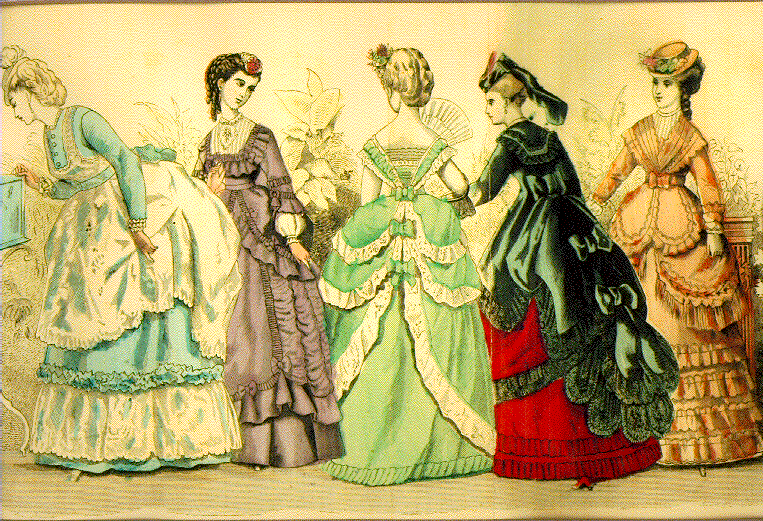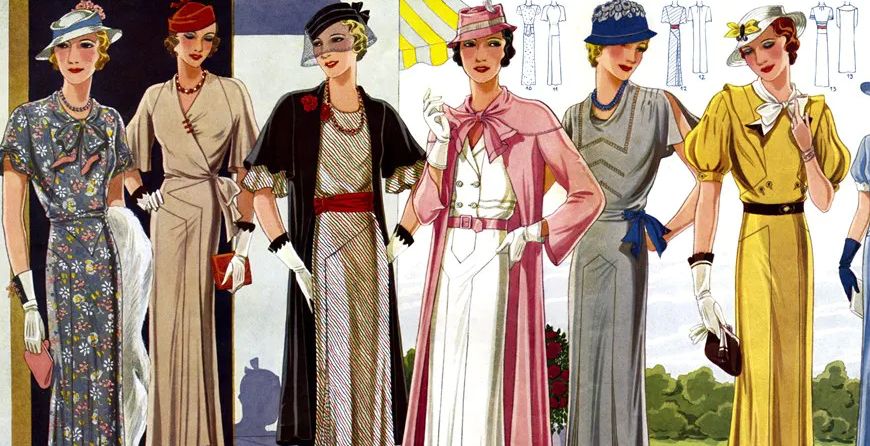By Pauline Weston Thomas for Fashion-Era.com

- The Victorian and Edwardian Seaside
- The Changing Coastline of Britain
- The New Entertainment
- Class Differences Between Seaside Visitors
- Sexuality at The Beach
- New Resorts
- Winter Gardens
- Bathing Machines
- Promenading
- Seaside Fashions
The Victorian and Edwardian Seaside
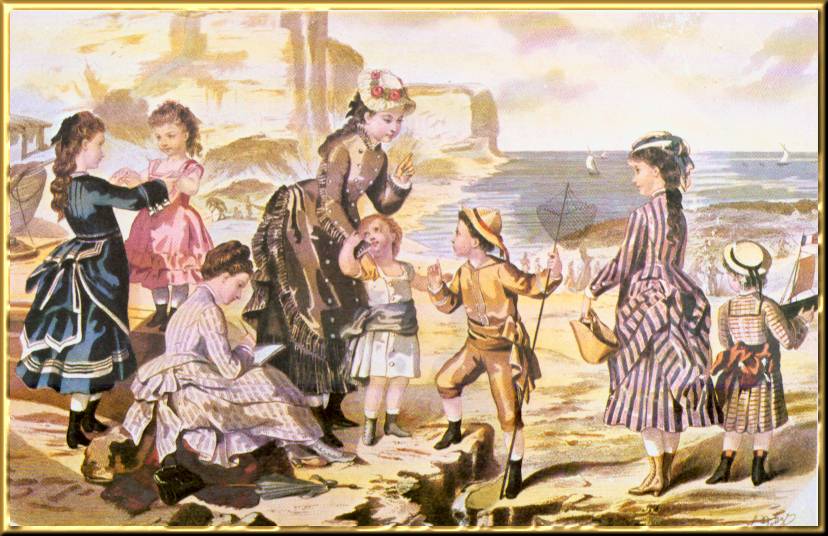
Until the 19th century the British were disinterested in the seaside areas of the coast. Then in the mid 19th century the seaside resorts began to lose their character of substitute spas where people went for mineral health waters. Instead they became holiday places where the pursuit of pleasure was more important than health.
The establishment of railways gave them easier access to the coast for day trips or longer. Couples, single people and children all enjoyed the delights of being beside the seaside.
The Changing Coastline of Britain
Coastal popularity began in the mid 18th century when a doctor, Richard Russell promoted the drinking of sea water as a cure all for diseases from jaundice to gout. Visitors set about making the same atmosphere that had existed at spa venues such as at Bath Assembly rooms.
Reading rooms for card games and raffles and other amusements were created for the benefit of visitors. Success of this depended on there being approximate social equality between guests. When the railways arrived hordes of people of all classes swarmed into the resorts.
The New Entertainment
With the new visitors new forms of entertainment and catering developed. Street musicians, Punch and Judy shows, minstrel shows, acrobats, whelk stands, ice cream carts, travelling photographers, and pedlars all swarmed the beaches and promenades turning them into fair grounds.
Some resorts, with poor communication remained picturesque. The rest of them grew and developed into highly organised towns with properly regulated local services, which provided housing, transport, lighting, sanitation and all the amenities needed to satisfy residents and visitors. The British seaside with boarding houses, landladies, donkeys and piers was all the rage.
By 1900 the coast of Britain was populated with towns and villages. The changing circumstances of the population previously imprisoned in industrial towns longed for freedom and the seaside provided the escape. Escape from industrial mid Victorian Britain was generally shown as absenteeism on Mondays, excessive drinking, crime, gambling, and violence.
To everyone the sea was a place where social life and social pleasures were the main aim. In a class ridden society one of these pleasures was the knowledge of emulating one's superiors.
Social Class Differences Between Seaside Visitors
The status of visitors who stayed at resorts was a recommendation for the place and an attraction for the visitor. Kings, Queens, Princes, Princesses or other aristocracy were sought after guests.
Lists of visitors names, plus their accommodation address at a resort were published in the local newspapers.
Snobbery, rivalry and envy was rife. Everyone joined in the game of hunting celebrities or trying to identify them as they rode in their carriages or strolled up and down the esplanade. As the century moved on, popular crowds increased and the smart visitor moved. The status symbols of resorts were now pierrots and black minstrels.
Sexuality at the Beach
The main appeal of the seaside resorts was that on the promenade and beach social differences, passed unnoticed. This would have been impossible at the former bath spas. At the beach people could relax as they chose. This kind of freedom gave the seaside a strong appeal which gradually broke down the prim attitudes of middle class society.
On the beach working class men and women less sophisticated manners and open sexual advances shocked the more genteel middle classes. The genteel soon sought remoter areas and holidayed as far as possible away from the uncouth. This started a passion for travel abroad.
Sexuality was openly pursued at the beach and promenade. Young men peered through telescopes at women descending into the sea from their bathing machines. It was no accident that the postcard whose theme is sexual humour should have developed at the seaside.
The seaside brought out the wilder nature of individuals. Even the architecture took on a more exotic style and in the winter tropical plants provoked romantic images of the jungle. Here the dull workaday world could be put aside for a week or two and be replaced by a fantasy world.
New Resorts
Brighton was the first major seaside town and was patronised by the Prince Regent, but it soon began to feel the effects of a new clientele after the rail line was installed in 1841. The railway soon made it Britain's most popular resort.
Blackpool, Southport, Scarborough, Llandudno, Ramsgate, Margate, Weymouth, Torquay, Dover, Ilfracombe, Ryde, Cowes and Worthing all became well known resorts.
Piers were developed as an extension of the promenades and took visitors right out to sea without getting wet or undressing. The parade and marina were as close most visitors would ever get to the ocean. The wealthy sailed along the coastline on their yachts and socialised among their own kind.
Winter Gardens
Architecture at seaside resorts introduced the Winter Garden as a new social venue previously held by assembly rooms. This was a huge cast iron structure covered with glass like huge conservatory or a huge green house.
It was the meeting place for visitors to listen to music, take tea or stroll among palms and ferns giving the illusion of a better more exotic climate. Many of the public gardens had a band stand as the centre piece.
Bathing Machines
For decades the bathing machines ruled the sea. These were rooms or wheels dragged into the sea by horse giving the privacy of indoor bathing.
No lady would have considered bathing without its protection. By Edwardian times ladies took to bathing from the beach and even walking about in their bathing costumes. By 1901 mixed bathing was usual.
You are reading an original 19th Century Seaside article by Pauline Weston Thomas at www.fashion-era.com ©
Promenading
As late as the early Edwardian period middle class ladies would never been seen paddling in the sea. Only their maids or children's nannies could do something so undignified as lower their guard so publicly. The highlight of the seaside day visit was not morning bathing or sitting on the beach, but the afternoon promenade.
Throughout the century, the walk about the town and particularly along the seafront, was an essential part of the life of a resort. Everyone came out to see and be seen.
The rich in their carriages, or on their horses and later in their motors. The rest on their feet, all dressed in their finest, but with the formal etiquette of the town now relaxed.
Seaside Fashions
The Victorian seaside visitor was clothes-conscious. Huge trunks were packed with clothes slightly less formal than those worn for town.
Ladies wore their crinolines and round hats, an impractical costume for blustery coasts and damp sands. As long as the clothes were fashionable they wore them. In the 1870s crinolines were exchanged for tight corsets and bustles.
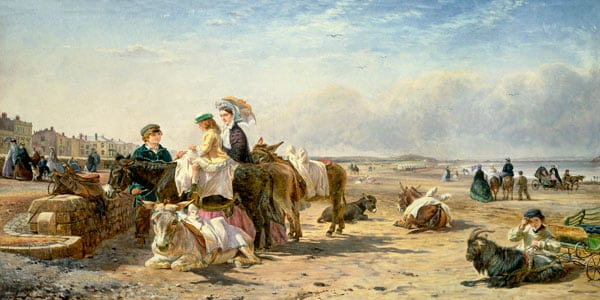
For general holiday wear and travelling to destinations women wore shorter skirts minus trains. Large ribbon streamer straw hats were a great seaside favourite in the mid 1850s.
Many paintings of the seaside illustrate the straw hat fashion alongside bonnets with brims with projecting frames of cane covered in silk. They were called 'uglies' and were used to shield a woman's face from the sun.
Young men tried to get a nautical or at least exotic flavour into their seaside dress. By the time of Edward VII they were appearing in shiny new straw boaters, richly striped blazers, bright cummerbunds and white flannels. Many local newspapers such as the Scarborough Gazette ran regular fashion notes.
This emphasis on dress highlights the fact that the seaside was something very special for Victorians and Edwardians, an escape from everyday life.
As sunbathing did not become fashionable until the 1920s ladies used hats and parasols to protect their white skin from the sun's harmful rays.
You are reading an original 19th Century Seaside article by Pauline Weston Thomas at www.fashion-era.com ©
Page Added 2001.
